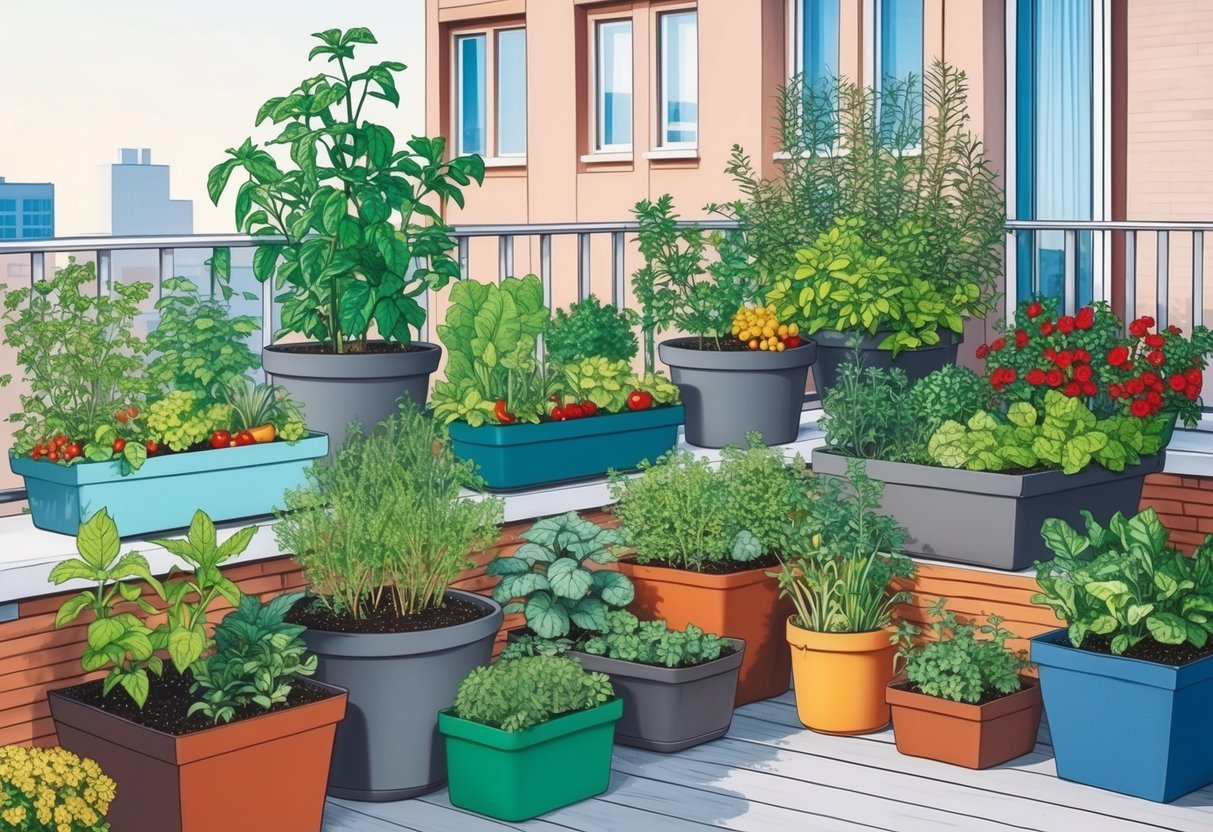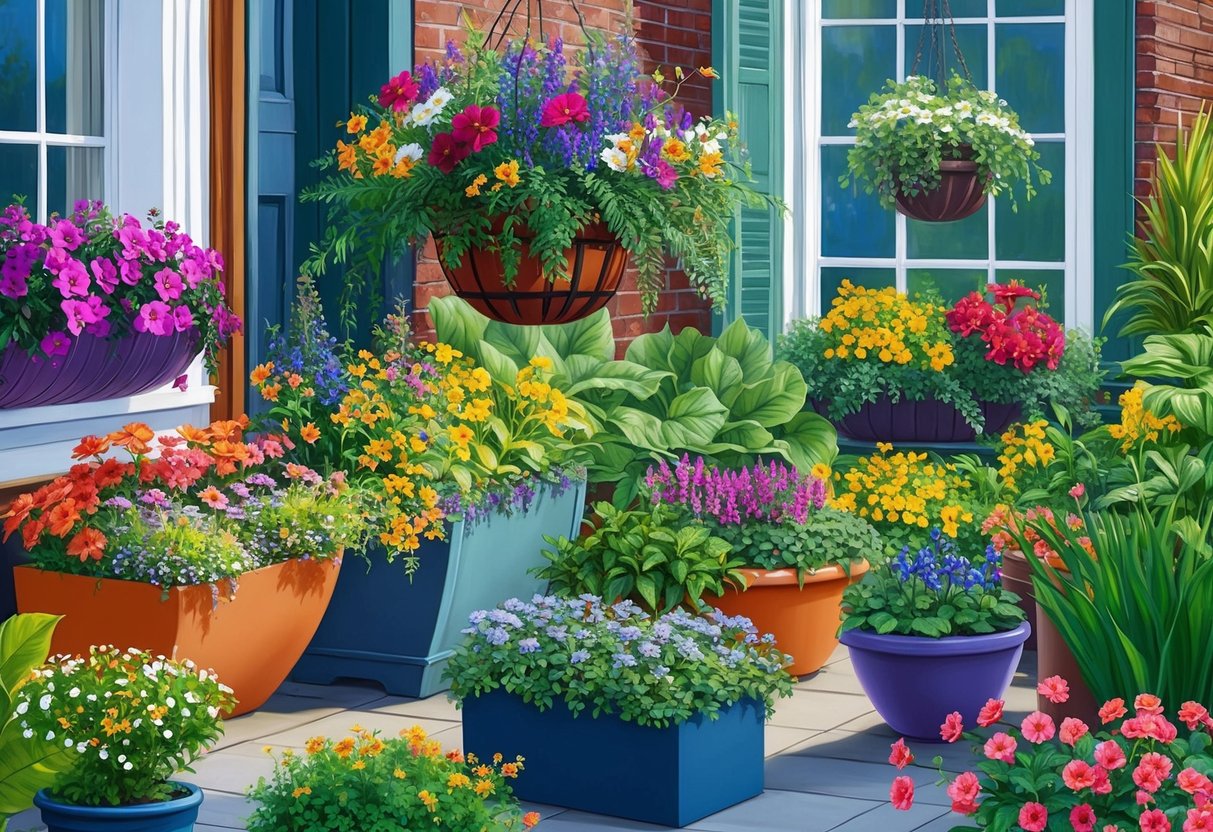
Plant Selection for Containers

The right choice of container plants greatly affects growth, health, and appearance. Thoughtful selection provides seasonal color, consistent texture, and opportunities for edible harvests in compact areas.
Choosing Suitable Annuals and Perennials
Balconies and patios often benefit from a mix of vibrant annuals and dependable perennials. Annuals like petunias, impatiens, and marigolds offer a season-long burst of color and are especially effective for quick, eye-catching results.
Compact zinnias and calibrachoa also thrive in pots, offering steady blooms. Perennials, such as coreopsis, heuchera, and compact daylilies, provide longer-term value, returning each year if properly cared for.
Dwarf ornamental grasses and small shrubs like boxwood can add structure and year-round texture. For those interested in native species, many will adapt well to pots and contribute to local biodiversity.
Tips for Success:
- Select container plants based on total mature size to avoid overcrowding.
- Pair flowering plants with different bloom times for maximum seasonal interest.
- Use high-quality potting mix and ensure good drainage to maintain root health.
For further ideas on choosing native perennials or woody plants that thrive in containers, consider the strategies outlined on Balcony Gardens: Planting Native Plants in Pots & Containers.
Incorporating Edibles
Edibles can be highly productive even in small pots. Herbs such as basil, parsley, and thyme are especially suited to tight spaces and can be harvested regularly for kitchen use.
Lettuce, spinach, and radishes grow rapidly and can be succession-planted for a steady yield. Compact or dwarf vegetable varieties, such as cherry tomatoes and patio cucumbers, are bred specifically for container growth.
Strawberries are ideal for hanging baskets or vertical planters. When mixing edibles with other container plants, ensure they have enough sunlight and avoid overcrowding to promote air circulation.
Containers for vegetables should be deep enough for root development and require more frequent watering, as pots dry out faster than garden soil. For step-by-step details on best practices, see Container Gardening for Small Spaces or explore practical strategies for growing vegetables vertically at Small Space Vegetable Gardening.
Creative Vertical and Tiered Gardening Methods
Maximizing growth in small spaces often comes down to using vertical garden structures and layered arrangements. By moving plants upward or stacking containers, gardeners increase yield and plant diversity while conserving ground area.
Building Tiered Planters
Tiered planters are an efficient way to organize herbs, vegetables, and flowers vertically. These structures can range from simple wooden shelves to purpose-built tiered garden towers.
Construction is straightforward; sturdy materials like treated wood, metal, or high-quality plastic offer lasting support for multiple plant layers. When assembling a tiered system, ensure each level gets sufficient sunlight and has proper drainage holes to prevent root rot.
Fill each tier with lightweight, nutrient-rich, well-draining soil and position sun-loving plants at the top, where they’re less shaded. Shade-tolerant varieties like lettuce or mint fit well on the lower levels.
Tiered planters are especially effective for balconies, patios, and even small courtyards, allowing for a mix of edible and ornamental plants. For more details about choosing materials and layering, the Vertical Veg Guide to Container Gardening offers practical advice specific to urban environments.
Installing Hanging Baskets
Hanging baskets excel at turning unused vertical spaces, such as walls and overhangs, into productive growing areas. They work best with lightweight potting mixes, and containers should have reliable drainage to minimize waterlogging.
Select baskets made from wire frames with coco liners, or plastic models with built-in reservoirs to keep soil moist and reduce watering frequency. Encourage healthy plant growth by choosing compact, trailing, or climbing species—such as cherry tomatoes, strawberries, or herbs like basil—that adapt well to vertical gardening setups.
Baskets should be secured with robust hooks or brackets, ensuring they’ll support the weight of watered soil and mature plants. By adjusting basket height, gardeners can optimize for sun exposure and make routine care tasks like watering and harvesting more accessible.
Find more creative ideas for hanging planters and plant selection in this guide on transforming small spaces.